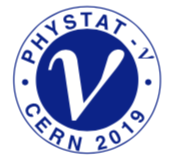The Borexino detector, located at the Laboratori Nazionali del Gran Sasso in Italy, is a liquid scintillator detector with a primary goal to measure solar neutrinos. The spectral fit of the energy spectrum has been performed for the first time in the whole energy range from 0.19 up to 2.93 MeV. This approach made it possible to obtain the fluxes of 7Be, pp, and pep solar neutrinos...
A typical experiment in high energy physics is considered. The result of the experiment is assumed to be a histogram consisting of bins or channels with numbers of corresponding registered events. The expected background and expected signal shape or acceptance are measured in separate auxiliary experiments, or calculated by the Monte Carlo method with finite sample size, and hence with finite...
Statistical data analysis of modern experiments deals with large-scale models with hundreds of nuisance parameters. Direct application on statistical methods such as likelihood profiling, Bayesian methods and especially Feldman-Cousins procedure can lead to extensive numerical computations.
In order to facilitate the growing need for flexible and high-performance analysis tools to deal...
Optimization problems in HEP often involve maximizing a measure of the sensitivity of the analysis to an hypothesis with respect to another; the latter is referred to as null hypothesis and in a frequentist framework is tested against the former, which is referred to as alternative hypothesis.
In most cases, it is desirable to fully compute the expected frequentist significance, accounting...
The canonical way to make experimental neutrino-cross-section data available for comparison with different theories and other experiments is to unfold it.
The aim of this is to remove the detector effects and efficiencies from the data to release distributions of variables of interest in "truth space".
Depending on the available data, the detector properties, and the variables of interest, it...
We are in an era of precision measurements at the Large Hadron Collider. The precision that can be achieved on some of the measurements is limited however due to large systematic uncertainties. This paper introduces a new technique to reduce the systematic uncertainty by quantifying the systematic impact of single events and correlating it with event observables to identify parts of the phase...
The statistical issues related to the search for sterile neutrinos are reviewed with focus on short-baseline appearance and disappearance experiments. The sensitivities for limit setting and signal discovery are discussed along with their dependency on the experimental parameters, including the signal rate and the spectral shape. Our baseline analysis is built on a profile-likelihood test...
Low-background experiments typically perform radioassay on detector construction materials, and use the resulting radioimpurity estimates to project experiment sensitivity. However, as the radiopurity of the materials improves and approaches the detection limit of the radioassay techniques, the radioimpurity concentration of the materials cannot be conclusively determined. Instead, only an...
I report the results of a search for $\bar{\nu}_{\mu} \rightarrow \bar{\nu}_{e}$ oscillations at the T2K experiment in a 3-flavour framework. An exposure of $1.49 \times 10^{21}$ Protons On Target (POT) is used in $\nu$ mode and $1.63 \times 10^{21}$ POT in $\bar{\nu}$ mode; an increase of $46\%$ in the $\bar{\nu}$ exposure compared to results reported in June 2018.
Results are reported for a...
